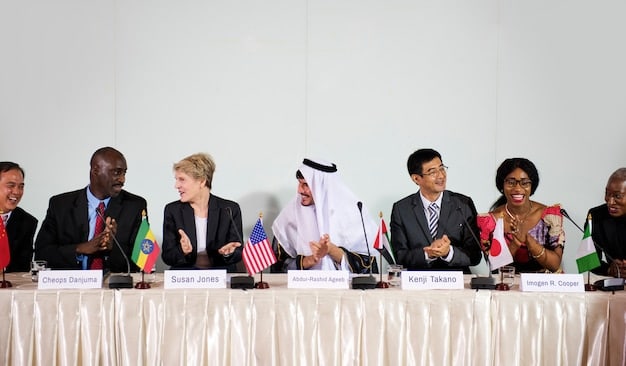Political Figures’ Climate Change Policies: Proposals and Implementation

Political figures are increasingly proposing and implementing diverse policies to address climate change, ranging from carbon emission reduction targets and investments in renewable energy to international agreements and adaptation measures for vulnerable communities, reflecting a growing global awareness and urgency.
Political leaders worldwide are grappling with the urgent need to address climate change. This article explores the evolving landscape of climate policies being proposed and implemented by political figures, highlighting key initiatives and their potential impact.
Understanding the Urgency: Climate Change and Political Action
Climate change is no longer a distant threat; it is a present reality affecting communities and ecosystems globally. Recognizing this urgency, political figures are now under immense pressure to enact meaningful policies. But what exactly does effective political action on climate change look like?
The Science Behind the Pressure
The scientific consensus on climate change is overwhelming, with reports from organizations like the Intergovernmental Panel on Climate Change (IPCC) painting a stark picture of potential consequences. This section explains the basics of climate science in an accessible way.
The Political Landscape of Climate Action
The political response to climate change is complex, varying greatly depending on national contexts, political ideologies, and economic priorities. This section explores the challenges and opportunities political figures face as they navigate this intricate landscape.
- Addressing the scientific evidence
- Balancing environmental protection with economic growth
- Building consensus across different political parties
- Navigating international cooperation
In summary, the urgency of climate change demands immediate and comprehensive political action. Political leaders face the complex task of translating scientific findings into effective policies while navigating various political and economic challenges.
Setting Targets and Timelines: Emission Reduction Policies
A critical aspect of political action on climate change involves setting ambitious emission reduction targets and establishing clear timelines for achieving them. These policies guide both national and international efforts to lower greenhouse gas emissions.
The Paris Agreement and its Goals
The Paris Agreement, adopted in 2015, represents a landmark achievement in global climate governance. This section delves into the agreement’s key objectives, including limiting global warming to well below 2 degrees Celsius above pre-industrial levels.
National Emission Reduction Targets
Many countries have pledged to reduce their emissions by specific percentages within a defined timeframe. Analyzing these national targets provides insight into the level of ambition and commitment of various political entities.

- Analyzing the pledges made under the Paris Agreement
- Comparing the emission reduction targets of different nations
- Assessing the feasibility of achieving these targets
- Understanding the role of carbon neutrality in mitigating climate change
In conclusion, emission reduction policies are crucial for mitigating climate change and achieving global climate goals. It is essential for political leaders to set ambitious targets and implement effective measures to reduce greenhouse gas emissions within specific timelines.
Investing in Renewables: Transitioning to Clean Energy Sources
One of the most promising approaches to combating climate change involves transitioning from fossil fuels to renewable energy sources. Political figures are increasingly advocating for policies that incentivize the adoption of solar, wind, and other clean energy technologies.
Incentives for Renewable Energy Adoption
Governments can use various fiscal and regulatory mechanisms to support the growth of renewable energy. This section examines the effectiveness of tax credits, subsidies, and feed-in tariffs in promoting clean energy adoption.
Infrastructure Development for Renewables
A successful transition to renewable energy requires significant investment in infrastructure, including transmission lines, energy storage solutions, and smart grids. Understanding these infrastructure needs is crucial for policymakers.
- Examining the role of government subsidies in supporting renewable energy
- Understanding the impact of renewable energy portfolio standards
- Analyzing the challenges of integrating renewables into existing power grids
- Exploring the potential of energy storage technologies
In summary, investing in renewable energy is a fundamental aspect of climate change mitigation. Political leaders must implement policies that incentivize the adoption of clean energy sources and facilitate the development of necessary infrastructure.
Carbon Pricing Mechanisms: Taxing Emissions and Promoting Efficiency
Carbon pricing mechanisms, such as carbon taxes and cap-and-trade systems, are designed to make polluters pay for the environmental costs of their emissions. These policies can encourage businesses and individuals to reduce their carbon footprint and invest in cleaner technologies.
Carbon Taxes: Making Polluters Pay
A carbon tax directly charges emitters a fee for every ton of carbon dioxide they release into the atmosphere. This section examines the economic and environmental impacts of carbon taxes.
Cap-and-Trade Systems: Creating a Carbon Market
Cap-and-trade systems set an overall limit on emissions and allow companies to buy and sell emission permits. This section analyzes the effectiveness of cap-and-trade systems in reducing emissions while fostering market-based solutions.

- Analyzing the economic impact of carbon taxes on industries and consumers
- Examining the effectiveness of cap-and-trade systems in driving emissions reductions
- Comparing the advantages and disadvantages of different carbon pricing mechanisms
- Understanding the potential for international carbon markets
In conclusion, carbon pricing mechanisms play a vital role in mitigating climate change by making polluters accountable for their emissions. Political figures should carefully consider the design and implementation of carbon taxes and cap-and-trade systems to maximize their effectiveness.
Adaptation Strategies: Protecting Vulnerable Communities
Even with ambitious mitigation efforts, some degree of climate change is inevitable. Adaptation strategies are essential for protecting vulnerable communities and ecosystems from the impacts of rising temperatures, sea-level rise, and extreme weather events.
Building Climate-Resilient Infrastructure
Investing in infrastructure that can withstand the impacts of climate change, such as stronger sea walls and more resilient buildings, is crucial for protecting communities. This section explores best practices in climate-resilient infrastructure development.
Disaster Preparedness and Response
Effective disaster preparedness and response systems are essential for minimizing the impacts of extreme weather events. This section examines strategies for enhancing disaster resilience and ensuring timely assistance to affected communities.
- Analyzing the role of urban planning in creating climate-resilient cities
- Examining the effectiveness of early warning systems for extreme weather events
- Understanding the importance of community engagement in adaptation planning
- Exploring the potential of nature-based solutions for climate adaptation
In summary, adaptation strategies are essential for protecting vulnerable communities and ecosystems from the unavoidable impacts of climate change. Political leaders must prioritize investments in climate-resilient infrastructure and disaster preparedness to safeguard their citizens.
International Cooperation: Working Together for Global Solutions
Climate change is a global problem that requires international cooperation to address effectively. Political figures must work together to forge international agreements, share best practices, and provide financial and technical assistance to developing countries.
The Role of International Agreements
International agreements, such as the Paris Agreement, provide a framework for global climate action. This section examines the importance of multilateral cooperation in achieving climate goals.
Financial and Technological Assistance
Developed countries have a responsibility to provide financial and technological assistance to developing countries to help them mitigate and adapt to climate change. This section explores mechanisms for ensuring equitable access to resources and technologies.
- Analyzing the impact of international climate negotiations on national policies
- Examining the role of international organizations in facilitating climate action
- Understanding the challenges of enforcing international climate agreements
- Exploring the potential of technology transfer to accelerate climate solutions
In conclusion, international cooperation is essential for achieving global climate goals. Political leaders must prioritize multilateralism, share best practices, and provide financial and technological assistance to developing countries to address climate change effectively.
| Key Point | Brief Description |
|---|---|
| 🎯 Emission Reduction | Setting and achieving targets to lower greenhouse gas emissions. |
| ☀️ Renewable Investment | Transitioning to clean energy sources like solar and wind power. |
| 💰 Carbon Pricing | Implementing taxes or systems to make polluters pay for emissions. |
| 🤝 Global Cooperation | Working with international partners for climate solutions. |
Frequently Asked Questions
▼
The Paris Agreement is an international treaty on climate change, adopted in 2015. It aims to limit global warming to well below 2 degrees Celsius above pre-industrial levels and to pursue efforts to limit the temperature increase to 1.5 degrees Celsius.
▼
Carbon taxes are a form of carbon pricing where a tax is levied on the carbon content of fossil fuels. This tax increases the cost of activities that generate greenhouse gas emissions, incentivizing businesses and individuals to reduce their carbon footprint.
▼
Climate change is a global problem that requires collective action. International cooperation allows countries to share best practices, set common goals, and provide financial and technological assistance to developing nations, ensuring a coordinated global response.
▼
Investing in renewable energy reduces reliance on fossil fuels, decreases greenhouse gas emissions, improves air quality, and creates jobs. It also enhances energy security and promotes sustainable economic development, contributing to a cleaner and healthier environment.
▼
Communities can adapt to climate change by building climate-resilient infrastructure, enhancing disaster preparedness, implementing early warning systems, and engaging in community-based adaptation planning. These measures help minimize the impacts of extreme weather events and protect vulnerable populations.
Conclusion
In conclusion, political figures play a crucial role in addressing climate change through the policies they propose and implement. From setting emission reduction targets and investing in renewable energy to implementing carbon pricing mechanisms and promoting international cooperation, their actions shape the future of our planet. By prioritizing sustainable policies and working together, they can create a more resilient and environmentally conscious world.





